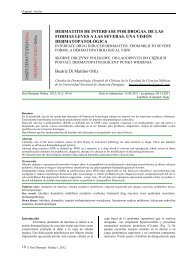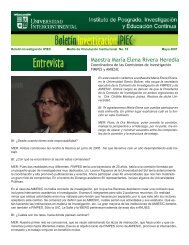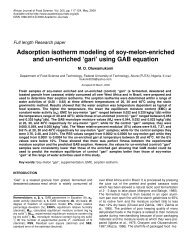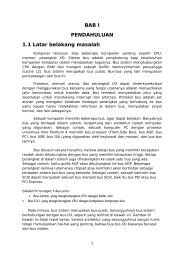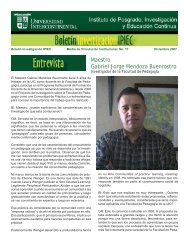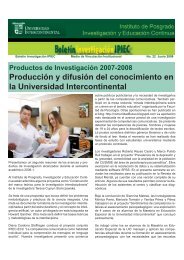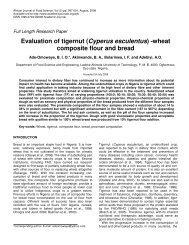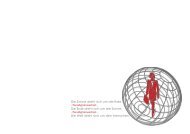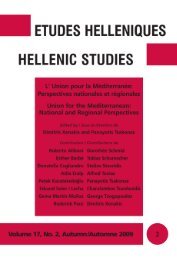Antimicrobial screening of stem bark extracts of ... - Science Stage
Antimicrobial screening of stem bark extracts of ... - Science Stage
Antimicrobial screening of stem bark extracts of ... - Science Stage
You also want an ePaper? Increase the reach of your titles
YUMPU automatically turns print PDFs into web optimized ePapers that Google loves.
El-Mahmood et al. 093<br />
and whose pharmacognostic significance <strong>stem</strong> from the<br />
fact that they combine with a numerous variety <strong>of</strong> compounds<br />
to form glycosides. The presence <strong>of</strong> glycoside<br />
moieties like saponins, anthracene and cardiac glycolsides,<br />
some <strong>of</strong> which are known to structurally resemble<br />
sex hormones (oestrogens, gestrogens and androgens)<br />
are known to protect against gastric infections caused by<br />
enteric pathogens thus justifying the use <strong>of</strong> this plant in<br />
traditional medicine practice. All the <strong>extracts</strong> from the<br />
different solvents demonstrated antimicrobial activity with<br />
the ethanol <strong>extracts</strong> demonstrating the highest activity.<br />
Variation in activity among different extracting solvents<br />
has earlier been reported (Falodun et al., 2006). Differences<br />
in polarity among various solvents have been<br />
reported to be accountable for the differences in solubility<br />
<strong>of</strong> plant active principles, hence variation in degree <strong>of</strong><br />
activity. The water <strong>extracts</strong> however, demonstrated the<br />
least activity against all the test bacteria. When plant<br />
materials are grounded in water or the plant cells are<br />
damaged, some phenolases and hydrolases are <strong>of</strong>ten<br />
released and these enzymes might have modulatory<br />
effect on the activity <strong>of</strong> the active compounds in the<br />
extract or there may incomplete extraction <strong>of</strong> the active<br />
principles thus explaining the low activity. Traditionally,<br />
however crude plant <strong>extracts</strong> are prepared with water as<br />
infusions, decoctions and poultices, therefore it is very<br />
unlikely that the herbalist is able to extract all these<br />
compounds, which are responsible for the activity<br />
observed in acetone and ethanol <strong>extracts</strong>. Generally,<br />
acetone and ethanol showed broader and greater spectra<br />
<strong>of</strong> activity against the tested organisms.<br />
Results also showed that activity <strong>of</strong> all the <strong>extracts</strong><br />
were concentration dependent. Similar results have been<br />
reported by several researchers. Highest activity was<br />
demonstrated by the standard antibiotic chloramphenicol<br />
(control). This is because the antibiotic is in pure state<br />
and has refined processes that have established it as a<br />
standard antibiotic (Prescott et al., 2002).<br />
The organisms used for the purpose <strong>of</strong> this investigation<br />
are associated with various forms <strong>of</strong> infections; S.<br />
dysentriae (dysentery), K. pneumoniae (pneumonia), P.<br />
mirabilis (wound infections), E. coli (gastrointestinal tract<br />
infections) and S. typhi (typhoid fever) (Prescott et al.<br />
2002). Results <strong>of</strong> this investigation therefore have shown<br />
that V. paradoxa is a potential source <strong>of</strong> antibiotic substances<br />
for drug development for use against this group<br />
<strong>of</strong> enteric organisms. In earlier works however, K. pneumoniae<br />
was observed to be resistant to the aqueous,<br />
methanol and acetone <strong>bark</strong> <strong>extracts</strong> <strong>of</strong> eight plants used<br />
for traditional medicine in Paraguay. In this investigation<br />
however, ethanol and acetone <strong>bark</strong> <strong>extracts</strong> inhibited the<br />
growth <strong>of</strong> K. pneumoniae significantly. The ethanol<br />
<strong>extracts</strong> <strong>of</strong> the <strong>stem</strong><strong>bark</strong> was previously found to inhibit<br />
the growth <strong>of</strong> E. coli and P. mirabilis (Legrand et al.,<br />
1988).<br />
Acid and alkaline treatment was carried out in order to<br />
slightly simulate the stomach and duodenal conditions and<br />
also to predict the condition under which the drug would<br />
be more effective, if it is to be formulated for com-mercial<br />
purposes and since the plant is also used in the<br />
treatment <strong>of</strong> constipation and diarrhea traditionally. As<br />
the temperature <strong>of</strong> the <strong>extracts</strong> was increased, their activity<br />
also gradually increased. It is assumed that the<br />
increase in temperature increases the activity <strong>of</strong> the<br />
bioactive components <strong>of</strong> the <strong>extracts</strong> probably due to<br />
increased solubility. This explains why traditionally, the<br />
<strong>extracts</strong> are still effective in remedying the ailment they<br />
are being used to against; besides the <strong>extracts</strong> are taken<br />
while still warm ensuring effectivity and consequently<br />
their continued usage in traditional medicine.<br />
Demonstration <strong>of</strong> low MIC and MBC values by especially<br />
the ethanol <strong>extracts</strong> is an indication that the phytoconstituents<br />
<strong>of</strong> the plant have therapeutic properties and<br />
therefore justifies its traditional medicinal uses.<br />
Conclusion<br />
Results from this study showed the therapeutic activity <strong>of</strong><br />
V. paradoxa against some selected members <strong>of</strong> the<br />
enterobacteriaceae. The plant can therefore be used to<br />
manage enteric infections like diarrheal diseases. Toxicological<br />
studies, purification and identification <strong>of</strong> the plant<br />
active principles should be em<strong>bark</strong>ed upon in addition to<br />
investigating its activity on a wider range <strong>of</strong> bacteria and<br />
fungi.<br />
REFERENCES<br />
Acheampong YB, El-Mahmood MA, Olurinola PF (1988). The<br />
Antibacterial properties <strong>of</strong> the liquid Antiseptic TCP. Indian J. Pharm.<br />
Sci. (3): 183-186.<br />
Agbahungba G, Depommier D (1989). World Oil Seeds Chemistry,<br />
Technology and Utilization. Van Nostraud Rein Hold, New York. p.<br />
554.<br />
Cheesbrough M (2002). District Laboratory Practice in Tropical<br />
Countries Part II; Cambridge University Press UK. pp.136-142.<br />
Dalziel JM (1937). Useful Plants <strong>of</strong> West Africa. Crown Agents London,<br />
p. 612.<br />
El-khier JM, Salim MH (1980). Investigation <strong>of</strong> certain plants used in<br />
Sudanese folk medicine Fitoterapia. 51: 143-147.<br />
Emeruwa KC (1982). <strong>Antimicrobial</strong> Substances from Carica papaya<br />
FruitExtracts. J. Nat. Products. 45(2): 125-127.<br />
Ell<strong>of</strong> JN (1998). Which extract should be used for the <strong>screening</strong> and<br />
isolation <strong>of</strong> antimicrobial components from plants<br />
Ethnopharmacology. 60: 1-8.<br />
Falodun A, Okunrobo LO, Uzoamaka N (2006). Phytochemical<br />
<strong>screening</strong> and anti-inflammatory evaluation <strong>of</strong> methanolic and<br />
aqueous <strong>extracts</strong> <strong>of</strong> Euphorbia heterophylla Linn (Euphorbiaceae).<br />
Afr. J. Biotechnol. 5(6): 529-531.<br />
Ferry MP, Gessain M, Geeain R (1974) Vegetative Propagation <strong>of</strong><br />
Shea, Kola and Pentadesma. Cocoa research institute, Ghana<br />
Annual Report (1987/88): 98-100.<br />
Latha SP, Kannabiran K (2006). <strong>Antimicrobial</strong> Activity and<br />
Phytochemical <strong>of</strong> Solanum trinobatum Linn. Afr. J. Biotechnol. 5(23):<br />
2402-2404.<br />
Legrand A, Wandergema PA, Verpwites R, Pousset JL (1985).<br />
Antinfectious Phytotherapies <strong>of</strong> the tree Savanna <strong>of</strong> Senegal (West<br />
Africa) II. <strong>Antimicrobial</strong> Activity <strong>of</strong> 33 species. J. Enthnopharmacol.<br />
1: 25-31.<br />
Lino A, Deogracious O (2006). The In vitro Antibacterial Activity <strong>of</strong><br />
Annona senegalensis, Securidacca longipendiculata and<br />
Steganotaenia araliacea – Ugandan Medicinal Plants. Afr. Health



